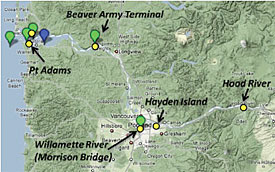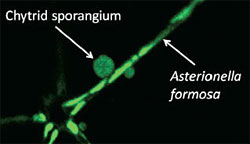You are here
Even protists get infections
![]() Download science brief as a pdf
Download science brief as a pdf
ISSUE
The dominant primary producers in the Columbia River (CR; Fig. 1) are the diatoms, single-celled eukaryotic microorganisms (‘protists’) encased in silica (glass) shells. Diatoms thrive when nutrients are plentiful; they draw down carbon dioxide as they photosynthesize and represent an important food source for zooplankton. Diatoms generally perish through grazing by zooplankton or by limitation of nutrients or light required for growth. Recent observations suggest that some diatoms are susceptible to infection by fungal parasites called chytrids. Although these infections have been noted since the mid 1900’s, their dynamics and potential impacts remain very poorly understood. Related chytrid species are responsible for massive infections of amphibians worldwide. The factors responsible for disease outbreaks remain unclear. The objectives of the present study are to (1) establish the distribution and frequency of chytrid infections among diatoms in the CR system, including the river, estuary, and plume; (2) determine the conditions under which they occur; and (3) assess their potential ecological impacts.
APPROACH
Michelle Maier (M.Sc student) and Tawnya Peterson (Ph.D.) initiated the study based on observations of diatom parasitized by chytrids in the Columbia River estuary in April 2009. Near Pt Adams (Fig. 1), colonies of the diatom Asterionella formosa included some cells with attached fungal sporangia (Fig. 2).

Figure 1. The Columbia River system with observatory endurance stations (green balloons) and chytrid sampling sites (yellow circles).
Sampling was conducted at sites in the estuary and river as well as in the river plume during spring and summer 2009. The samples were preserved with 0.5% glutaraldehyde and stained with a chitin-binding fluorophore specific to fungi. Chytrid parasites were identified based on morphological features and illumination by the stain. Further sample analysis included extraction of DNA and amplification of specific regions spanning the 18S and internal transcribed spacer regions of the ribosomal DNA to identify different chytrid species. Samples are being enumerated to establish infection rates (number of chytrids per cell and number of infected diatoms).
FINDINGS
The observations revealed that diatoms are susceptible to infection by chytrid fungi in the Columbia River Coastal Margin (CRCM). Infected cells often appeared devoid of contents, indicating that infections could account for diatom mortality. Chytrids occurred in at least three diatom species (Aulacoseira italica, Fragilaria crotonensis, and A. formosa) in the river and estuary from April until at least September – ongoing sampling will reveal whether the infections persist through the winter months. The specificity of the parasite-host relationship is not clear. Intriguingly, infected diatom cells were also observed within the estuary turbidity maximum, providing a potential mechanism by which chytrid populations may be retained in the system to carry out subsequent infections.

Figure 2. Colony of A. formosa with chytrid sporangia. Chloroplasts in the diatom cells are green due to autofluorescence. Use of the fluorescence microscope generously provided by M. Haygood.
IMPLICATIONS
In lakes, the infection of diatoms by chytrid fungi can divert energy flow from a classical diatom-grazer-fish food chain to a so-called ‘mycoloop’, where fungi acquire nutrients from diatom hosts saprophytically and zooplankton graze on fungal zoospores. The consumption of fungal zoospores by zooplankton can relieve grazing pressure on phytoplankton. The diversion of energy into the mycoloop has implications for nutrient cycling and trophic transfer efficiency that remain very poorly understood.
MORE
Ongoing work seeks to (1) establish the spatial and temporal distribution of chytrid infections in the CRCM; (2) determine whether infections of diatoms alter nutrient cycling in the river; and (3) show whether fungal infections can impact diatoms in the adjacent coastal ocean via the river plume. Understanding the dynamics of diatom infections may yield important clues about potential reservoirs of chytrid fungi.



